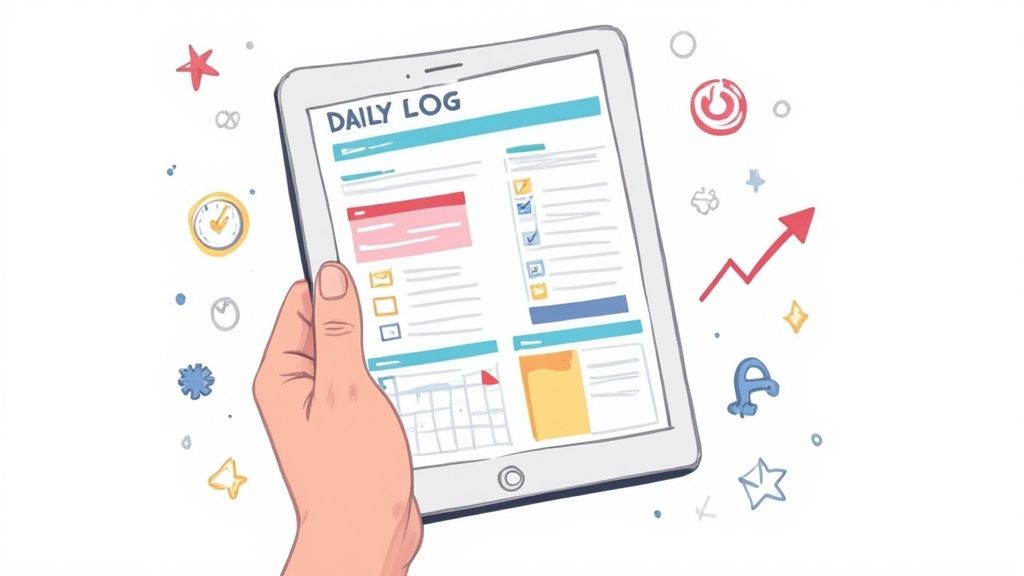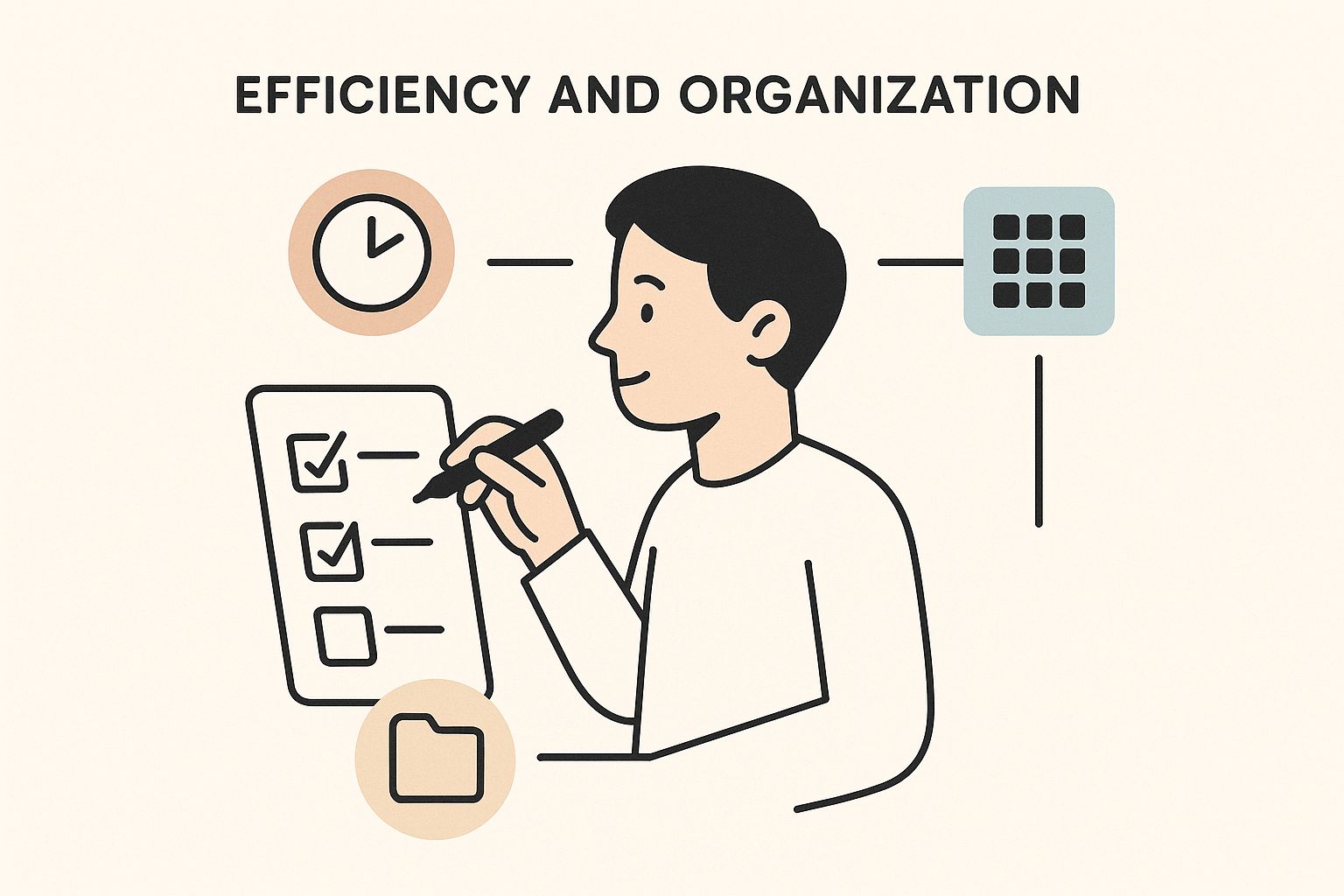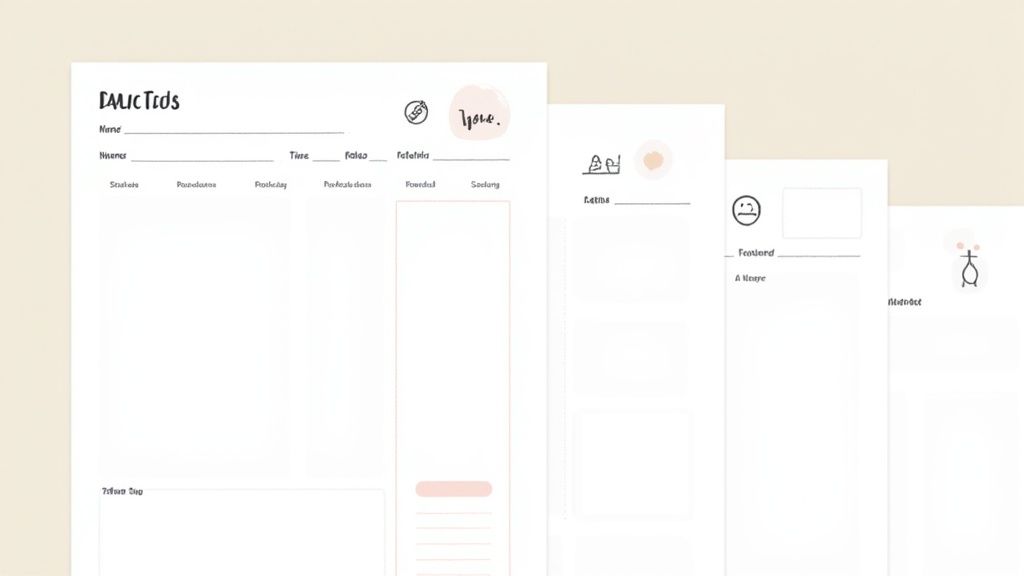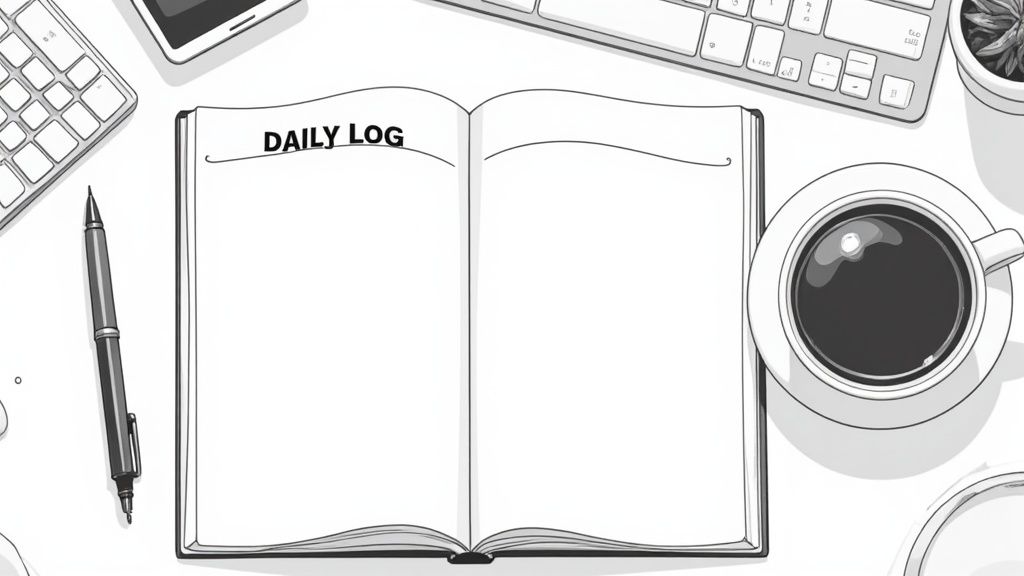Daily Log Templates to Master Your Productivity

At its heart, a daily log template is simply a pre-made framework that helps you organize your daily tasks, notes, and goals into a consistent, easy-to-use format. Think of it as your personal command center, designed to bring real structure and intention to your day by turning fuzzy plans into concrete, actionable steps.
Why a Daily Log Is Your Productivity Command Center
Ever feel like you’re just reacting to your day instead of directing it? It’s like trying to pilot a ship without a rudder—plenty of motion, but no clear direction. A daily log is that rudder. It gives you control over where you’re headed and how you get there.
This is so much more than a simple to-do list; it’s a system for managing your focus.
By using a structured log, you can effortlessly track tasks, capture those fleeting thoughts that always seem to disappear, and actually see your progress from one day to the next. This simple practice cuts down on mental clutter because you’re no longer trying to juggle every single reminder and idea in your head. Instead, everything has its place.
The Foundation of a Focused Life
A daily log template immediately makes this powerful concept a practical, everyday tool. It gives you the columns, sections, and prompts you need to get started without any friction. This single document can become the bedrock for a more organized and effective life, both at home and at work.
It empowers you to:
Gain Clarity: Start each day knowing exactly what your priorities are.
Maintain Momentum: Visibly track what you’ve completed, which is a huge motivator.
Capture Knowledge: Create a dedicated space for ideas, meeting notes, and reflections.
Improve Over Time: Look back at past logs to spot patterns and fine-tune your approach.
Beyond just organizing your day, a daily log is a key tool for building comprehensive workflow optimization strategies, which can dramatically boost your overall output.
A great daily log template doesn’t just tell you what to do; it shows you what you’ve done. This record of small wins creates a powerful feedback loop that fuels sustained effort and achievement.
This move toward structured daily planning isn't just a niche habit. The global market for diaries and planners, which includes both physical and digital daily log templates, was valued at around $1.15 billion. It’s projected to climb to $1.6 billion by 2033, which really shows a growing appreciation for the power of personal organization. You can read more about these market size trends for planners at 360researchreports.com.
Integrating a daily log template into your routine offers a range of benefits that compound over time. The table below breaks down the core advantages and their real-world impact.
Key Benefits of Using a Daily Log Template
Increased Productivity
Prioritizing tasks and minimizing distractions leads to more focused work sessions.
You get more meaningful work done in less time, freeing up your schedule.
Reduced Mental Clutter
Offloading thoughts, tasks, and ideas onto a structured document clears your mind.
Less stress and anxiety from trying to remember everything.
Enhanced Self-Awareness
Reviewing past logs reveals patterns in your habits, energy levels, and focus.
You learn what works for you and can make adjustments for better performance.
Improved Accountability
A written record of goals and progress creates a sense of personal responsibility.
You're more likely to follow through on commitments to yourself and others.
Ultimately, a daily log is more than just a list—it's a tool for reflection and growth, helping you build a more intentional and productive life one day at a time.
For those of us using Obsidian, Obsibrain takes this to the next level. It provides intelligent, automated daily log templates that actually connect your daily actions with your bigger knowledge base. For example, a project manager can see a real-time summary of all project-related tasks and notes directly in their daily log, creating a truly unified command center for their entire life.
Anatomy of an Effective Daily Log Template
What really separates a high-impact daily log from a glorified to-do list? It all comes down to the components. A great template isn't just about listing what you have to do; it’s a smart system where every part has a job, working together to sharpen your focus and self-awareness.
The best daily log templates are built on a few core pillars. These aren't just random sections thrown onto a page. They are specific tools designed to help you manage your time, energy, and attention. It’s this thoughtful structure that transforms a blank note into a command center for your day.
Core Components for Daily Success
A truly useful daily log goes way beyond just checking off tasks. It needs to have elements that help you prioritize what’s important, focus on one thing at a time, and reflect on your day. Here are the essentials:
A Prioritized Task List: Instead of a long, chaotic list that causes more stress than it solves, this section uses a framework. Think something like the Eisenhower Matrix (Urgent/Important). This forces you to work on what actually matters, not just whatever is making the most noise.
A Time-Blocked Schedule: This is your game plan. It's a visual layout that helps you carve out dedicated blocks of time for deep work. By assigning tasks to specific time slots, you’re not just hoping you’ll get to them—you’re making an appointment with your priorities.
A ‘Brain Dump’ Area: This is absolutely crucial. It’s an unstructured space to offload all the random thoughts, half-baked ideas, and nagging reminders that pop into your head. Getting them out of your mind and onto the page clears up a surprising amount of mental clutter.
This infographic breaks down how these pieces fit together to create a streamlined system for keeping your day organized and efficient.

As you can see, a solid daily log works like a funnel. You start by prioritizing, then you move into scheduled action, and finally, you reflect on how it all went.
Advanced Elements for Deeper Insight
Once you’ve got the basics down, you can add components that are all about long-term growth and consistency. These features are what turn your daily log from a simple productivity tool into a system for continuous improvement.
For example, a habit tracker gives you a simple, visual way to see if you’re sticking to new routines, which is fantastic for building momentum. An end-of-day review section prompts you to think about what went right, what went wrong, and what you learned.
This reflective practice is the engine of improvement. By consistently analyzing your day, you gather the data needed to make smarter decisions about your time and energy tomorrow.
This move toward structured daily planning isn't just happening in personal productivity. Look at the daily newsletters market—it's expected to jump from $14.2 billion to $23.92 billion by 2033, according to these insights into the daily newsletters market. People are clearly hungry for tools and content that bring a little order to the daily chaos.
This is where Obsibrain really shines within Obsidian. It doesn't just give you a static template. It connects your prioritized tasks, daily reflections, and habit trackers directly into your main knowledge base. For a writer, this means a daily log can automatically show progress on a book manuscript and link to character notes, creating a living document that grows and evolves right along with you.
Finding the Right Daily Log Template for Your Life
Choosing the right productivity tool is a deeply personal thing; there’s really no one-size-fits-all solution. A daily log template that’s a game-changer for a freelance designer might feel totally restrictive to a startup CEO. The goal is to land on a system that clicks with your own unique workflow, turning your log from a chore into a natural extension of how you already think.
This means asking yourself the right questions before you commit to a certain style. Does your day demand a strict, time-blocked schedule, or do you thrive with more flexible, unstructured blocks for deep work? Do you need to track hard data and metrics, or is your main priority just having a space for brainstorming and creative ideas?
Digital vs. Paper: The Great Debate
One of the first big decisions is picking between digital and paper. Paper gives you that tangible, screen-free experience that many people find incredibly satisfying. On the other hand, digital templates offer flexibility, searchability, and automation that paper just can't match.
The real magic of a digital log isn't just about replacing paper—it's about building an interconnected system. With the right tools, your daily log becomes a living, breathing part of your entire knowledge ecosystem, not just a standalone document.
For instance, using a digital tool like Obsidian lets you link your daily tasks directly to project notes, meeting summaries, and long-term goals. This creates a rich web of context that a paper notebook simply can't replicate.
For those who love the feel of a pen but crave digital perks, pairing an iPad with an Apple Pencil is a fantastic middle ground. You get to keep the mindful practice of writing by hand while gaining the security and searchability of a digital file. It’s become a popular way to get the best of both worlds.
Choosing Your Template Style
Once you've settled on a format, the next step is picking a style that fits your personality and needs. Here are a few common types of daily log templates you'll come across.
The Minimalist: This template is clean, simple, and straight to the point. It often just has a prioritized to-do list and a small spot for notes. It's perfect if you want to focus on the absolute essentials without getting bogged down.
The Comprehensive Planner: This style has it all—a detailed hourly schedule, habit trackers, meal planning, gratitude prompts, you name it. It’s ideal for detail-oriented folks who want a single place to manage every part of their day.
The Reflective Journal: This template is a blend of task management and structured reflection. It might include prompts for an end-of-day review or a "5-4-3-2-1" grounding exercise. It’s built for anyone who wants to focus on personal growth right alongside their productivity.
Here you can see a few different styles side-by-side, from simple task lists to more complex, structured planners.

The key takeaway here is that the visual structure of a template has a huge impact on how you approach and interact with your day.
Inside Obsidian, Obsibrain gives you the power to build and customize your own perfect daily log. A researcher could start with a minimalist template for daily tasks and gradually layer in automated queries that pull in relevant literature notes or experiment data as their needs change. This flexibility ensures your daily log always works for you, not the other way around.
Automate Your Daily Log with Obsibrain
A well-structured daily log template is powerful, but let's be honest—the manual setup each morning can feel like a chore. Copying unfinished tasks, linking up your notes, and checking on project statuses all take time away from the actual work. This is where a little automation can transform your daily log from a static document into a dynamic, intelligent dashboard.
Think of Obsibrain as the smart engine inside Obsidian, built specifically to handle the repetitive parts of your daily planning. It turns your standard daily note into a self-updating command center, saving you time and giving you a much clearer view of how your daily actions connect to your long-term goals. Imagine your daily log essentially building itself every morning, ready for you to dive right in.
From Static Note to Dynamic Dashboard
Obsibrain brings several key automations to the table that are designed to eliminate busywork. These features take care of the tedious administrative tasks that so often bog down the daily logging process, freeing you up to focus on what really matters—making progress.
A huge advantage of digital daily logs is the ability to how to automate repetitive tasks, turning what was once manual entry into a fluid, almost effortless process. Obsibrain is built entirely on this principle.
Here are a few of the key automations:
Automated Task Roll-over: Any task you didn't finish yesterday automatically shows up in today's log. You’ll never lose track of open items again, and there’s no need to manually copy and paste anything.
Intelligent Note Syncing: When you create a meeting note for a specific project, Obsibrain can automatically link it back to that project's main page and any relevant contacts. Your knowledge base starts to build itself, organically.
Live Project Dashboards: You can embed a real-time summary of a project's status directly into your daily note. This gives you an at-a-glance view of your progress without ever needing to leave your daily plan.
Here’s what an automated daily note powered by Obsibrain can look like. It seamlessly blends your tasks, calendar, and project statuses into one cohesive view.
The screenshot shows how unfinished tasks from the previous day are automatically carried over, project summaries are embedded for a quick review, and your schedule is integrated right where you need it. It creates a single source of truth for your entire day.
Connecting Daily Actions to Long-Term Goals
This level of automation does more than just save you a few minutes each morning; it fosters a more connected and meaningful workflow. When your daily activities are automatically linked to your larger projects and goals, you get a much clearer perspective on how your small, everyday efforts contribute to the bigger picture.
Obsibrain’s automation isn't about removing you from the process; it's about removing the friction. By handling the logistics, it frees up your mental energy to focus on strategic thinking and deep work.
This shift toward smarter, automated logging solutions isn't just a personal productivity hack; it’s a trend reflected across many industries. The global log management market, which includes tools and daily log templates for complex sectors like IT, was valued at roughly $2.51 billion. It’s expected to keep growing as AI and machine learning become more integrated into how we analyze data.
For anyone looking to bring these kinds of powerful workflows into their own system, Obsibrain offers an accessible entry point. A freelancer, for example, can use it to automatically generate daily logs that pull in all tasks and meetings related to their active clients. You can learn more about setting all this up by checking out our guide on Obsibrain’s daily planning features. By automating your daily log, you're not just organizing your day—you're building a smarter, more responsive system for achieving your goals.
Building a Daily Logging Habit That Sticks

Let's be honest: even the most beautiful daily log template is worthless if it just sits there collecting digital dust. The real magic happens with consistency, when logging stops feeling like a chore and becomes a natural part of your daily rhythm. This isn't about brute force or finding some mythical source of motivation. It's about building small, sustainable rituals that anchor your day.
The secret is to start small. Forget about blocking out an hour for meticulous planning. Simple, repeatable actions are what build habits that last. By lowering the barrier, you make it easy to show up every day—even the chaotic ones.
The Morning Plan and Evening Review
A powerful way to frame your day is to split your logging into two quick, manageable chunks: a morning plan to set your intentions and an evening review to process what happened. Think of them as bookends for your day, providing both direction and closure.
The 5-Minute Morning Plan: Before your day runs away from you, take just five minutes to get your bearings. This isn't about creating a rigid, minute-by-minute schedule. It's about asking a simple question: "What are the one to three most important things I need to accomplish today?" That simple act of intention-setting can frame your entire day with purpose.
The 10-Minute Evening Review: At the end of the day, spend ten minutes with your log. What went well? Where did things go off the rails? This isn't about beating yourself up; it's about gathering data. This brief reflection is your chance to spot hidden productivity killers and mentally reset for tomorrow.
By consistently reviewing your day, you begin to see your daily log not just as a task manager, but as a personal database of your own work patterns. You can identify your most productive hours, recognize energy dips, and make smarter decisions about how you allocate your time.
This is where a tool like Obsidian really shines. With Obsibrain, this review process becomes smarter. For example, a student can use it to automatically track study hours for different subjects, revealing which topics are getting the most attention and which might need more focus. You can learn more about this in the documentation on Obsibrain’s habits tracking capabilities.
Staying Flexible and Spotting Patterns
Life is messy and unpredictable. Your daily logging habit needs to be flexible enough to roll with the punches. Missed a day? Don't sweat it. The goal is consistency, not perfection. Just pick it back up the next day. The key is to have a system that’s so simple it’s easy to come back to.
Over time, your collection of daily notes becomes an incredibly valuable dataset about you. By looking back at past entries, you can start to identify your personal energy cycles. Maybe you discover your best creative work happens before noon, or that you always hit a slump after lunch.
Armed with that self-knowledge, you can start structuring your days around your natural rhythms. You can schedule deep, focused work for your peak energy windows and save the mindless admin tasks for when you're feeling sluggish. This data-driven approach, powered by your own daily observations, is how a simple logging habit evolves into a powerful tool for long-term focus and clarity.
Frequently Asked Questions About Daily Logs
Diving into daily log templates is exciting, but it's natural for a few questions to pop up along the way. You might be wondering about the best format, how to stick with it, or what to do when your day goes off the rails. Getting these details ironed out makes all the difference.
Let's tackle some of the most common hurdles people face when getting started.
What Is the Difference Between a Daily Log and a Journal?
Think of a daily log as your productivity command center. It’s structured and task-focused, designed to help you manage your to-dos and keep projects moving forward. A journal, on the other hand, is usually more free-form—a space for introspection, exploring feelings, and capturing memories.
But here’s the thing: with modern tools, you don't have to choose.
A platform like Obsidian completely blurs that line. You can embed reflective, journal-style entries right inside your structured daily log. You get the best of both worlds in one place, without ever needing to switch apps.
How Do I Stay Motivated to Use My Daily Log Every Day?
Here's a little secret: motivation doesn't lead to action; it's the other way around. The real key is to make the habit so frictionless that you barely have to think about it. Start with an incredibly simple template and tie the habit to something you already do, like sipping your morning coffee.
But the biggest motivator of all? Seeing real results.
When you use a tool like Obsibrain, it handles the boring stuff for you, which is a huge motivational boost. For a sales professional, it can automatically pull in meetings from your calendar and create links to contact notes, so you're not just staring at a blank page. That small head start is often all it takes to keep the momentum going.
How Can a Daily Log Help If My Day Is Unpredictable?
When your day is a whirlwind of a dozen different things, a daily log isn't a rigid cage—it's an anchor. Its job isn't to lock you into a strict schedule, but to give you clarity on your core priorities before the chaos hits.
When the inevitable fire-drill lands on your desk, your log is there to help you quickly figure out what's actually important and what can wait. Use it as a dynamic tool to capture new requests and make deliberate choices. This ensures the truly critical work doesn’t get drowned out by the noise of false urgency.
Can I Use Obsibrain If I Am New to Obsidian?
Yes, absolutely. Obsibrain was designed to make Obsidian's powerful features accessible, even if you're just starting out. You don't need to be an expert to get immediate value.
You can begin by using only the daily note feature and let Obsibrain manage all the complex, automated template setup behind the scenes. For instance, you can start by simply listing tasks, and Obsibrain will automatically carry over unfinished ones without you needing to configure anything. If you get curious and want to understand more, you can learn about what a template is within Obsibrain's system. This lets you see the benefits of a structured daily log right away, without having to first master every single feature Obsidian has to offer.
Ready to transform your daily planning from a chore into a powerful, automated system? With Obsibrain, you can build a connected, intelligent daily log inside Obsidian that saves you time and keeps you focused on what truly matters. Get Obsibrain and start building a smarter workflow today.
Last updated
Was this helpful?